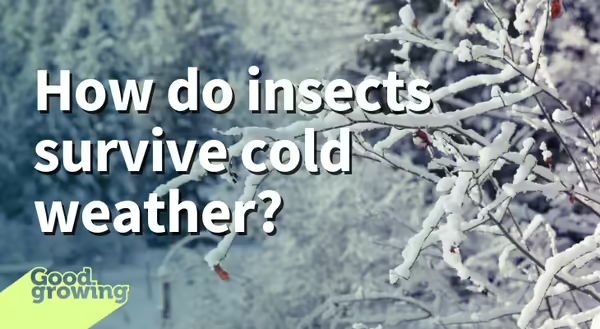
Winter can be harsh, especially with the arrival of snow and sub-zero temperatures. While we often retreat indoors or add a few more layers to avoid cold temperatures, many other critters, like insects, must tough it out outdoors. While they may seem delicate, insects have developed a variety of strategies to deal with the arrival of cold temperatures.
Leave the cold behind: migration
Some insects that we find in Illinois won’t survive our freezing winter temperatures. So, instead of trying to make it through the winter here, they’ll survive elsewhere. The most well-known example of this is monarch butterflies. As we approach fall, monarchs will begin to migrate south and will eventually reach Mexico, where they will overwinter. As temperatures begin to warm again come spring, they will begin migrating north, and their children or grandchildren will arrive in Illinois.
Others, like armyworms and potato leafhoppers, won't migrate south (they die in northern parts of the country) but will survive in southern states and will move north as temperatures begin to warm.
Stick around and tough it out
Many insects are year-round residents in Illinois and, depending on the species, may overwinter as eggs, nymphs/larvae, pupa, or adults. For many of these insects, low temperatures aren’t necessarily the problem; the formation of ice crystals in their bodies is. If ice crystals rapidly form in their bodies, their cells will burst, resulting in damage and likely death.
Some insects, like woolly bear caterpillars, will avoid this by using chemicals to control the way in which and where they freeze and, therefore, minimize damage to their cells. When warm weather returns in spring, the ice will melt, and they become active again (these insects are called freeze tolerant).
The other strategy insects that stick around for the winter use to survive is to produce chemicals in their bodies to avoid freezing altogether (these insects are called freeze intolerant). As temperatures begin to cool, these insects will start creating anti-freeze chemicals, such as glycerol. These chemicals allow the insect's bodies to supercool (reach temperatures below freezing, 32ᵒF). Therefore, the insects won’t freeze until they reach their supercooling point. Some insects that take this approach include Japanese beetles (supercooling point is 19ᵒF), emerald ash borer (supercooling point is -13ᵒF), and codling moth (supercooling point is -10ᵒF).
Just because temperatures don’t hit the supercooling point of an insect, it doesn’t mean some won’t be killed. For example, a study done by the U.S. Forest Service showed that 5% of the insects die at 0ᵒF, 34% at -10ᵒF, 79% at -20ᵒF, and 98% at -30ᵒF. That being said it’s important to note that emerald ash borer doesn’t overwinter in exposed areas.
Finding shelter: protection from the cold
While air temperatures can get cold enough to kill insects, most insects will overwinter in protected areas where temperatures do not get nearly as cold. For example, white grubs (like Japanese beetles) in the soil will not be exposed to extremely cold temperatures because the soil will insulate them. Others will seek shelter under leaf litter (codling moth), under bark (emerald ash borer), or even in your home (brown marmorated stink bug). All of these will provide some protection from cold temperatures.
Snow is also an excellent insulator and offers another layer of protection. Several inches of snow can potentially keep the ground temperatures dozens of degrees warmer than the air temperature. Snow also helps protect from large temperature fluctuations in the soil, which can be detrimental to insects as well as plants.
While cold temperatures will likely kill some insects, most will survive just fine. Come spring, it should be business as usual, which could be a good or bad thing, depending on your perspective.
Good Growing Fact of the Week: Honeybees are some of the few insects adapted to survive winter without becoming dormant. They will form clusters in their hives and keep warm by vibrating their flight muscles, which generates heat to keep the colony warm.
Resources and more information
Venette, Robert C. and Mark. Abrahamson. “Cold hardiness of emerald ash borer, Agrilus planipennis: a new perspective.” (2010). https://www.fs.usda.gov/Internet/FSE_DOCUMENTS/stelprdb5191794.pdf.
Sign up for our emails! Want to get notified when new Good Growing posts are available? SIGN ME UP
Give us feedback! How helpful was this information (click one): Very helpful | Somewhat helpful | Not very helpful
MEET THE AUTHOR
Ken Johnson is a Horticulture Educator with University of Illinois Extension, serving Calhoun, Cass, Greene, Morgan, and Scott counties since 2013. Ken provides horticulture programming with an emphasis on fruit and vegetable production, pest management, and beneficial insects. Through his programming, he aims to increase backyard food production and foster a greater appreciation of insects.